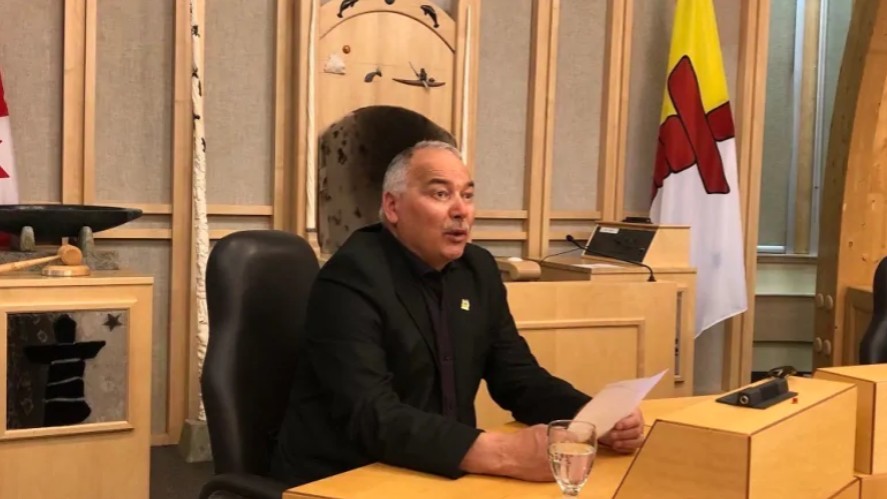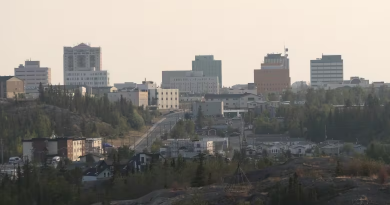Health teams ‘working around the clock’ to contain spread of COVID-19 in Arctic Canadian territory of Nunavut, officials say

Territory continues lockdown as 4 new COVID-19 cases reported on Monday, dozens over the weekend
Nunavut is entering the first full week of its “circuit-breaker lockdown” following a spike in COVID-19 cases over the weekend. There are 132 active cases across the territory as of Monday.
Four new cases of COVID-19 were announced on Monday, three in Rankin Inlet, bringing that community’s total to 18 and one in Whale Cove, bringing its total to 16 cases.
The announcement came as Premier Joe Savikataaq and Chief Public Health Officer Dr. Michael Patterson gave the territory’s first update of the week Monday morning, along with Minister of Health Lorne Kusugak .
There are no new cases in Arviat, though Patterson warned last week that daily case announcement can be more reflective of testing turnaround than the actual spread of the virus in the community.
“Because of the timing of testing, the variability of plane flights, the numbers will go up and down from day to day regardless of what’s happening in the community,” Patterson said. “Say they’re weather-delayed and we may not be able to get a number of samples until the next day. So it could literally go from zero one day to a large number the next day.”
98 cases in Arviat
On Monday, Patterson said health teams are still finding evidence of community transmission in Arviat, but they not sure if its residual or ongoing transmission.
There are 98 cases in Arviat. Two previous cases in Sanikiluaq have since recovered.
All active cases are currently in isolation and doing well with mild to moderate symptoms, according to a news release from the territory Monday.
Patterson said health teams are “working around the clock” to trace, test, isolate and contain the spread and that it would take some time to see if the current public health measures are working.
How exactly COVID-19 entered Nunavut is still unknown, Patterson said, as the government’s focus continues to be community support.
An environmental health officer from Nunavut was flown to Winnipeg to inspect its isolation hubs, while another team is reviewing the policies associated with Nunavut’s southern isolation hubs.
A public health physician is looking at links that could have led to infection with Manitoba Public Health also involved in the the review, Patterson said.
He expects new cases to continue to be announced, but says if new case numbers continue be fewer, he said to take that as evidence, health measures are succeeding in breaking transmission.
Sanikiluaq outbreak status
While Sanikiluaq’s two cases have recovered, the outbreak in the community is not yet over, Patterson said. That will happen 28 days after the last infected person’s 10 days of infection.
“There’s a worldwide accepted standard that from the time somebody starts symptoms — or the date that a swab was collected — 10 days later they’re no longer infectious,” Patterson said.
Sanikiluaq’s second case was identified on Nov. 8.
Once contact tracers are no longer finding new cases and all contacts with cases are in isolation with their test results known, Patterson says contract tracing will be paused.
He reassured Nunavummiut that experienced contract tracers are good at getting the information they need about a person’s contacts while maintaining confidentiality.
Isolation reminders
Patterson took the opportunity of Monday’s press conference to speak about the importance of following isolation measures, especially for those who have been identified as contacts of positive COVID-19 cases.
“People can still spread the virus when they don’t have symptoms, this is what we mean when we say asymptomatic transmission, some people can spread the virus up to two days before developing symptoms, and some can spread the virus for 10 days without ever developing symptoms,” Patterson said.
He explained that by the time people know they are sick, they will have infected many more, who will also spread the virus.
The government has received general complaints that some people are not following isolation rules, but since there have been no specific complaints with names and dates, there have been no fines issued for violating public health orders, Patterson said.
Someone who is asked to isolate should keep to their own space in a house as much as possible and high traffic areas in the house should be disinfected regularly.
They are not supposed to go to the grocery store, instead they should ask friends and family to pick up supplies and drop them off, he said.
When asked about fears related to dropping off groceries to those in isolation and how those without credit cards can order food, Savikataaq said the hamlet of Arviat is dropping off food hampers to affected families.
The territorial government is working with the Department of Family Services, to makes sure food is delivered and those on income support can have their cases evaluated over the phone, Savikataaq said.
“No reason to panic”
In a Saturday news release, Savikataaq said he knows the number of COVID-19 cases in Nunavut seem scary, “but it is not a reason to panic.”
“We will continue to see dips and rises in our case numbers for some time,” he said.
On Friday, the premier repeated his call for Nunavummiut to stay focused on containment efforts, including wearing masks and not socializing with people outside one’s household.
“This virus does not care how hard we’re working or how bored or tired we are,” he said in a Friday afternoon update.
“We do not get to relax for a single moment with what we’re doing. Please do not give it a chance to take more of a hold in any of our communities.”
Related stories from around the North:
Canada: Travel ‘bubble’ in northern Canada between N.W.T. and Nunavut suspended until further notice, CBC News
Denmark: Faroe Islands institutes new COVID-19 recommendations until the end of 2020, Eye on the Arctic
Iceland: New COVID-19 restrictions for Iceland’s schools and universities, Eye on the Arctic
Sweden: Sweden’s northernmost county among regions to introduce stricter COVID-19 recommendations, Radio Sweden
United States: After early containment success, there’s now rapid COVID-19 spread in rural Alaska, including the Arctic, Alaska Public Media



